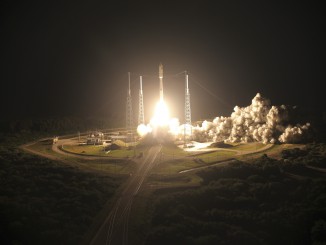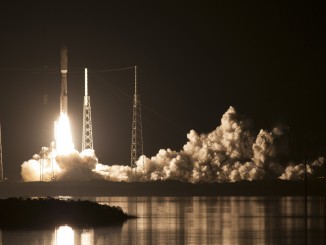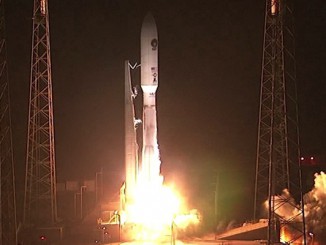
CAPE CANAVERAL — The payload will be mounted aboard the 200th Atlas-Centaur rocket Thursday, completing assembly of the most-powerful version of the vehicle available in the modern era.
Liftoff of the MUOS 3 satellite is scheduled for Jan. 20 during an evening window of 7:42 to 8:26 p.m. EST (0042-0126 GMT) from Complex 41.
At nearly 15,000 pounds, the Mobile User Objective System satellite is a hefty cargo requiring the most powerful version of the Atlas 5 to carry the payload into a highly elliptical geosynchronous transfer orbit.
The 551 configuration of the Atlas features five strap-on solid-fuel boosters and the five-meter-diameter nose cone. Previous flights have included hurling NASA’s New Horizons probe to Pluto and Juno to Jupiter.
It will be the first Atlas 5 of the year, the 52nd in the past decade and the third for the MUOS satellite series for the U.S. Navy. It will be United Launch Alliance’s 92nd launch and the first of 13 missions in 2015, following a 14-launch manifest successfully executed last year.
“It goes without saying: ULA had a banner year,” ULA CEO Tory Bruno said. “As we look ahead to 2015, we could not be more honored to continue supporting our nation in one of the most technologically complex, critical American needs: affordable, reliable access to space.”

The Atlas 5 and its Centaur upper stage will deliver the MUOS 3 spacecraft into a preliminary orbit about three hours after liftoff, allowing the Lockheed Martin-built satellite to begin its independent series of maneuverings to achieve a geosynchronous orbit 22,300 miles above Earth.
MUOS is a next-generation space communications system that utilizes commercial 3G cell phone technology to provide voice, data and video services to military troops on the move.
Each MUOS satellite is likened to a cell tower in the sky to serve ships, submarines, aircraft, land vehicles and terminals in the hands of troops. The design enables increases in the number of users and amount of communications that can be routed to military forces in contrast to current satellites.
When completed next year, the MUOS constellation will feature four primary birds and one spare in orbit to ring the planet and provide capacity, availability and global coverage for mobile military communications like never before.
MUOS 3 arrived in Florida in early November after being flown on an Air Force C-5 transport aircraft from Lockheed Martin’s satellite factory in Sunnyvale, Calif.
Unloading at the former Shuttle Landing Facility, the craft was taken to the commercial Astrotech satellite processing campus in nearby Titusville for final testing, the loading of propellants and encapsulation within the rocket’s payload fairing.

Crews early Thursday will move the satellite across Kennedy Space Center and down to the Vertical Integration Facility where the Atlas awaits the arrival of its cargo. MUOS will be hoisted atop the rocket to begin the connection process and complete the assembly of the 206-foot-tall launcher.
A tip-to-tail electrical check, called the combined systems test, will be run in the coming days to verify all is in readiness for flight.
Rollout of the Atlas 5 aboard its mobile platform to the launch pad is planned for Jan. 19. The launch team will initiate the seven-hour countdown at lunch-time on Jan. 20.
See our earlier MUOS 3 coverage.
And see our Atlas archive for further information.



